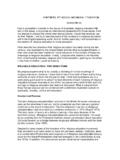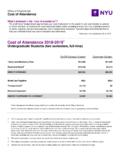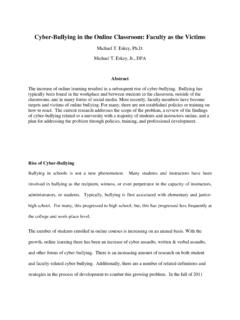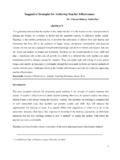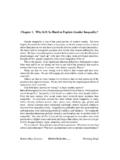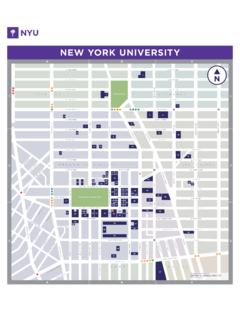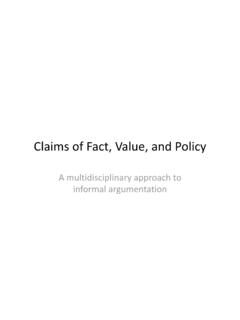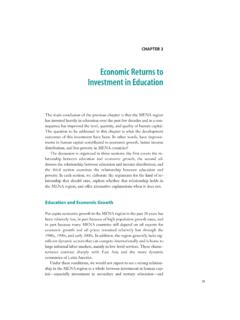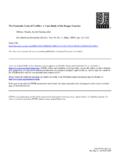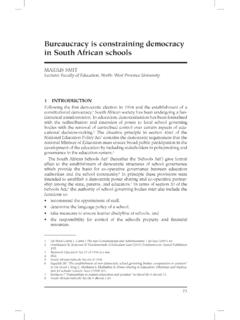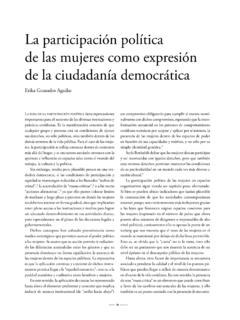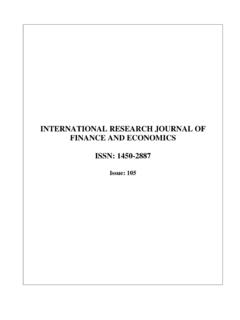Transcription of Alberto Bisin Dept. of Economics NYU January 12, …
1 Introduction to economic analysis Alberto Bisin Dept. of Economics NYU. January 12, 2011. Contents Preface ix 1 Introduction 1. Theory, Models, and Empirical Analyis .. 4. Debates .. 6. Predictions .. 7. Empirical analysis .. 11. Some successful results .. 13. Fun readings .. 14. Useful references .. 15. 2 Rational choice 17. Preferences .. 18. Rationality .. 19. Utility representation .. 21. Choice .. 24. Social choice .. 25. Classic references .. 26. Useful references .. 27. Problems .. 28. 3 Consumer choice 35. The Budget constraint .. 36. Indi erence curves .. 38. Monotonicity .. 41. Convexity .. 41. Types of preferences .. 43. Perfect substitutes .. 45. v vi CONTENTS. Perfect complements .. 45. Consumer problem .. 46. Demand Functions .. 49. Problems .. 50. 4 Equilibrium and e ciency 61. The Economy .. 62. Notation and De nitions .. 62. Pareto e ciency .. 63. The Social Planner problem.
2 64. Competitive equilibrium .. 66. Welfare Economics .. 67. The Edgeworth box .. 68. Externalities .. 70. Problems .. 70. 5 Equilibrium in the labor market 79. Competitive labor markets .. 79. Search frictions .. 80. Pareto ine ciency of search equilibrium .. 82. Empirical implications of search equilibrium .. 82. Problems .. 83. 6 Time and uncertainty 85. Choice over time; Saving .. 86. Intertemporal preferences for consumption .. 86. The intertemporal budget constraint .. 87. Choice over time, for given r .. 88. Determinants of savings .. 90. The interest rate r .. 90. In ation and Monetary Neutrality .. 91. Choice under Uncertainty; Portfolio choice .. 93. Probability .. 93. Expected Utility .. 94. Risk Aversion .. 95. State contingent consumption .. 95. Problems .. 96. CONTENTS vii 7 Growth 121. Production .. 122. Growth and Savings .. 123. Other Determinants of Growth .. 125. 8 Finance 129.
3 Asset Pricing and the CAPM .. 129. Portfolio Choice .. 130. Time and Risk Correction .. 130. Beta Representation .. 132. The Term Structure of Interest Rates .. 134. The Market Rate of Return and the betas .. 135. Equivalent Risk Neutral Representation .. 136. E cient Market Hypothesis .. 137. Idiosyncratic Risk Does Not A ect Prices .. 137. Prices Adjust Immediately to All Available Information 137. Risk Adjusted Prices Are Not Predictable .. 138. Arbitrage Opportunities Are Not Present in Financial Markets .. 138. Modigliani-Miller Theorem .. 140. Modigliani-Miller More Formally .. 140. Other Implicit Assumptions .. 142. Problems .. 143. 9 Incentives 157. Principal-Agent Problems .. 158. The symmetric information benchmarks .. 159. Moral hazard .. 161. Adverse selection .. 165. Social security .. 169. Other examples [to be added] .. 172. Problems .. 172. 10 Fiscal policy 175. Ricardian Equivalence - Arithmetics.
4 175. Borrowing-Constraints .. 177. Distortionary Taxes .. 178. Krugman, .., and the army of scal policy hawks .. 181. viii CONTENTS. Optimal taxation .. 186. Distortionary Taxation .. 186. Public Goods Provision .. 187. Time Inconsistency .. 191. Problems .. 192. 11 Empirical Economics 193. Correlation and regression analysis .. 195. Controlled experiments .. 198. Natural experiments .. 199. Structural econometrics .. 202. Problems with regression analysis .. 202. Back to models .. 205. Problems .. 205. 12 Game theory 207. Strategic Games .. 208. Nash equilibrium .. 209. Examples .. 209. Mixed Strategies .. 213. Dynamic Games .. 214. Bargaining .. 215. Reputation and repeated games .. 215. Problems .. 216. 13 Mathematical Appendix 217. Sets .. 217. Numbers .. 218. Vectors .. 219. Functions .. 219. Some Properties of Functions .. 220. Optimization .. 224. Solving the Cobb-Douglas Consumer's Problem.
5 229. Linear algebra .. 232. Reduction to echelon .. 233. Independent columns .. 234. Inverse matrix .. 235. Determinant .. 235. CONTENTS ix Problems .. 235. Sets and numbers .. 235. Derivatives .. 236. Maximization .. 240. Linear algebra .. 245. Preface Introduction to Economic Analysis is the introductory class I taught for several years at NYU. It is the rst class of the theory concentration major in Economics . Though this is not a plain vanilla Economics 101, it is nonetheless intended for students who wish to begin their formal study of Economics . Its goal is to develop concepts and analytical tools that economists use to understand general social and economic phenomena. This book originates as lecture notes for this class. As such the book relies on a relatively high level of abstraction and focuses on the concepts and the techniques of economic analysis rather than on the understanding of speci c economic phenomena or institutions.
6 It is particularly well suited for students/readers who are interested in pursuing careers or higher degrees in Economics or in quantitative elds such as nance. But readers who favor an analytic approach to their intellectual endeavors might nd the book enjoyable. Some math background is needed to read this book. I o er no apolo- gies. Economists very often express their ideas using mathematical concepts simply because these allow them to express themselves more precisely than with spoken language. Virtually, all the math used in the book is (or should be) taught in high school. We shall explain thoroughly any mathematical concept we use and we shall refer to the Math Appendix for details when necessary. How much the reader will get out of the book will depend more on how much fun he/she has doing math than on how much math he/she knows. My gratitude goes to James Ramsey, Director of Undergraduate Studies at NYU, for convincing me to teach in the undergraduate program and for having rst envisioned and then supported the whole idea of a course like Introduction to Economic Analysis.
7 My gratitude goes also to the many students who have su ered through various versions of my notes over the years. I am proud to report that two of them are now successful academic economists, Ahu Gemici at NYU and Laura Pilissoph at the University of Chicago. The book also owes a lot to an exceptional list of 's who have helped me and who wrote (and solved) most of the problems: Shachar Kariv, Mark Dean, Victor Archavski, Ignacio Esponda, Luke Geldermans. They are also all by now successful academic economists. The reader with some knowledge of the methodological distinctions in the Economics profession will certainly note a certain Chicago freshwater ix x Preface style prevailing in the book. My graduate school years at the University of Chicago in the early nineties have fundamentally marked the way I do (and teach) Economics . I enthusiastically take this occasion to thank Gary Becker, Jose'Scheinkman, Mike Woodford, Bob Lucas, John Cochrane.
8 For their help and their inspiration, as well as my closest peers there, Danilo Guaitoli, Afonso Mello Franco, Giorgio Topa, Fulvio Ortu. Jess Benhabib, Andy Schotter, Chuck Wilson in particular, have shaped my The book is dedicated to my son Vittorio. He was just learning to read when I started designing Introduction to Economic Analysis. Now he could read this book. Preface xi Preface 1. Chapter 1. Introduction [..] the di erence between Economics and sociology is very simple. Eco- nomics is all about how people make choices. Sociology is all about why they do not have any choices to make. (James S. Duesenberry). Adam Smith David Ricardo Economics is a broad-ranging discipline in scope. Consequently, various de nitions of Economics have been attempted, with mixed success. Perhaps the most in uential de nition is due to Lionel Robbins (in his 1932 essay on The Nature and Signi cance of Economic Science): Economics is "the science which studies human behavior as a relation- ship between ends and scarce means which have alternative uses.
9 ". 1. 2 CHAPTER 1 INTRODUCTION. The point of this de nition is to stress the issue of scarcity, essentially to point out that economists would be useless in Nirvana, where everybody is happy with an unlimited supply of anything they might desire. Without scarcity there are no choice problems; and no choice - no Economics ! More pragmatically, it is nowadays commonplace to implicitly de ne eco- nomics functionally, as follows: Economics is the study of a speci c set of phenomena we call eco- nomic;' demand and supply of commodities, market equilibrium and prices, e ects of monetary and scal policies, [..]. But this (as well as any) functional de nition is very narrow. Economists actively study phenomena which are traditionally attributed to sociology, an- thropology, political science, law, and even biology. Examples include: crime, family, fertility, primitive societies (like hunter-gatherers), voting, compara- tive analysis of political and legal institutions, social norms, social networks, genetic and cultural evolution of preferences, and so many others we do not have space to If a functional de nition of Economics is narrow, as the boundaries of the subjects studied in the discipline keep expanding, then we better rely on a methodological de nition.
10 An appropriate one could go something like this: Economics is the study of aggregate phenomena as equilibrium out- comes of individual choices. Individual choice and equilibrium analysis are in fact at the core of any economic analysis of whatever issue. These terms are somewhat jargony and hence it's better to be clear about how we interpret them at the outset. Individual choice. Individuals - not groups - make choices. When choos- ing individuals evaluate rationally costs and bene ts: they will choose the best bundle of goods for their money; they will sell assets they know are over- valued and will buy assets they know are under-valued; they will engage less 1. Applications to Economics outside of typically economic phenomena has a long tradi- tion in the discipline. The economist which is mostly responsible for this, who has studied strange subjects when it was not cool to do so but who ultimately has received a Nobel prize for his e orts along these lines, is Gary Becker, from the Univeristy of Chicago.
